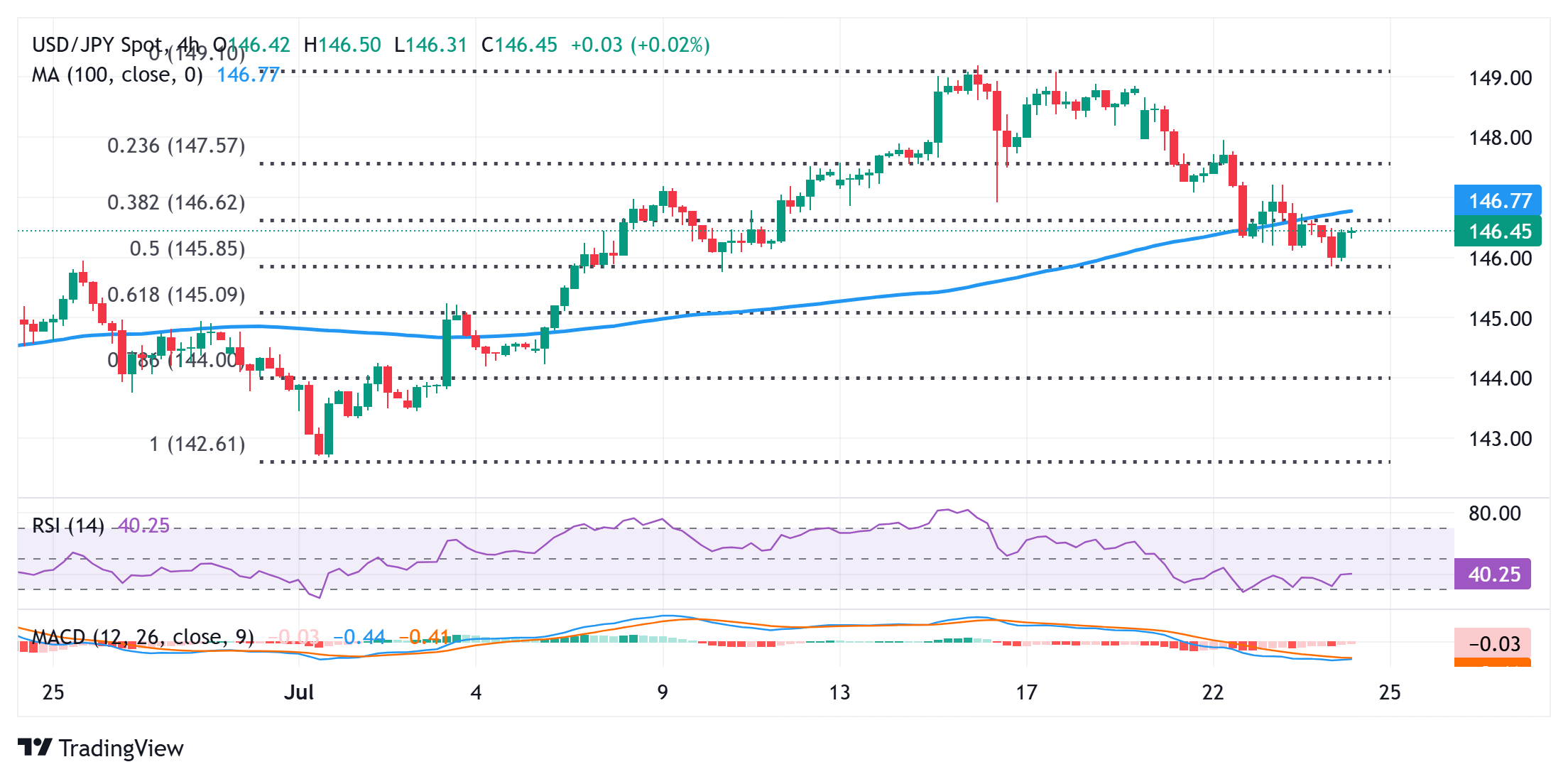
- USD/JPY rebounds after touching a two-week low amid the emergence of some JPY selling.
- Domestic political uncertainty, the risk-on mood, and disappointing PMI undermine the JPY.
- A modest USD bounce further supports the pair, though the upside potential seems limited.
The USD/JPY pair stages a goodish intraday recovery of over 50 pips from a two-week low touched earlier this Thursday and moves back closer to mid-146.00s during the first half of the European session. The prevalent risk-on environment, bolstered by the latest trade optimism, is seen undermining demand for traditional safe-haven assets, including the Japanese Yen (JPY). Reports suggest that the US and the European Union (EU) are heading towards a 15% tariff deal, which provides an additional boost to the global risk sentiment against the backdrop of the recently announced Japan-US trade agreement. Apart from this, the domestic political uncertainty and the disappointing data from Japan weigh on the JPY, which, along with a modest US Dollar (USD) recovery, prompts some intraday short-covering around the currency pair.
Japan’s ruling coalition – the Liberal Democratic Party (LDP) and its junior partner Komeito – suffered a defeat in the upper house elections last weekend. This adds a layer of uncertainty and fuels concerns about Japan’s fiscal health. Furthermore, a private-sector survey showed on Thursday that Japan’s manufacturing activity unexpectedly slipped into contraction during July. In fact, the S&P Global Japan manufacturing Purchasing Managers’ Index (PMI) dropped to 48.8 from June’s final reading of 50.1 as businesses assessed the impact from US tariffs. This overshadowed the upbeat Services PMI, which increased to 53.5 in July from 51.7 in the previous month. However, Japan’s trade deal with the US has removed economic uncertainty, suggesting that conditions for the Bank of Japan (BoJ) to hike rates further may start to fall in place again.
In fact, BoJ Deputy Governor Shinichi Uchida reiterated on Wednesday that the central bank’s course of action is to continue raising interest if the economy and prices move in line with forecasts. Moreover, a Reuters poll showed that a majority of economists expect the BoJ to hike its key interest rate again by the year-end, though most expect the central bank could wait for some time and would stand pat at this month’s meeting. Nevertheless, reviving BoJ rate hike bets, which helped offset Thursday mixed data from Japan, could limit JPY losses. The USD, on the other hand, might struggle to attract follow-through buyers amid the uncertainty over the Fed’s rate cut path. Furthermore, fears that the US central bank’s independence could be under threat, amid mounting political interference, might cap the upside for the Greenback and the USD/JPY pair.
In fact, US President Donald Trump has been personally attacking Fed Chair Jerome Powell for not lowering interest rates and has repeatedly called for his resignation. The markets, however, do not expect an interest rate cut from the Fed in July despite Trump’s continuous push for lower borrowing costs. Nevertheless, Trump-Powell standoff warrants some caution for the USD bulls. Traders now look forward to the release of the flash US PMIs for some impetus. Thursday’s US economic docket also features the release of the usual Weekly Initial Jobless Claims and New Home Sales data. This, in turn, might influence the USD price dynamics and contribute to producing short-term trading opportunities around the USD/JPY pair.
USD/JPY 4-hour chart

Technical Outlook
From a technical perspective, an intraday breakdown below the 100-period Simple Moving Average (SMA) was seen as a fresh trigger for the USD/JPY bears. Moreover, oscillators on the daily chart have just started gaining negative traction. Hence, the recovery momentum is more likely to confront stiff resistance near the said support breakpoint, currently pegged near the 146.60 region. The said area now coincides with the 38.2% Fibonacci retracement level of the upswing in July.
A sustained strength beyond, however, could lift the USD/JPY pair to the 147.00 round figure. This is closely followed by the overnight swing high, around the 147.20 area, which, if cleared, could allow spot prices to accelerate the move up towards the 147.60-147.65 intermediate hurdle en route to the 148.00 round figure.
On the flip side, bearish traders might now wait for some follow-through selling below the 145.85-145.75 region (July 10 low) before placing fresh bets. The subsequent fall could drag the USD/JPY pair to the 145.20-145.15 region, or the 61.8% Fibo. retracement level, en route to the 145.00 psychological mark.
Information on these pages contains forward-looking statements that involve risks and uncertainties. Markets and instruments profiled on this page are for informational purposes only and should not in any way come across as a recommendation to buy or sell in these assets. You should do your own thorough research before making any investment decisions. FXStreet does not in any way guarantee that this information is free from mistakes, errors, or material misstatements. It also does not guarantee that this information is of a timely nature. Investing in Open Markets involves a great deal of risk, including the loss of all or a portion of your investment, as well as emotional distress. All risks, losses and costs associated with investing, including total loss of principal, are your responsibility. The views and opinions expressed in this article are those of the authors and do not necessarily reflect the official policy or position of FXStreet nor its advertisers. The author will not be held responsible for information that is found at the end of links posted on this page.
If not otherwise explicitly mentioned in the body of the article, at the time of writing, the author has no position in any stock mentioned in this article and no business relationship with any company mentioned. The author has not received compensation for writing this article, other than from FXStreet.
FXStreet and the author do not provide personalized recommendations. The author makes no representations as to the accuracy, completeness, or suitability of this information. FXStreet and the author will not be liable for any errors, omissions or any losses, injuries or damages arising from this information and its display or use. Errors and omissions excepted.
The author and FXStreet are not registered investment advisors and nothing in this article is intended to be investment advice.








